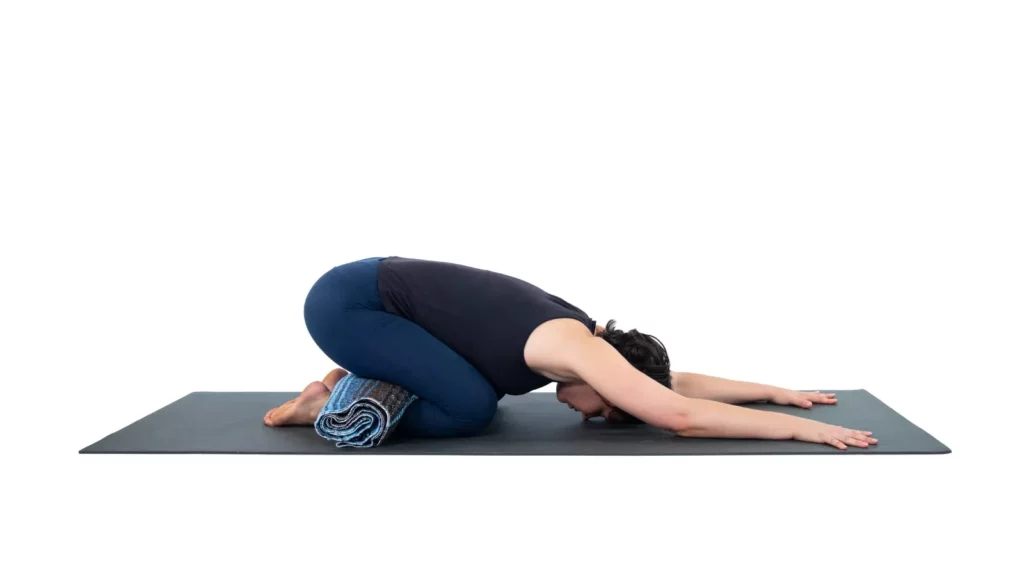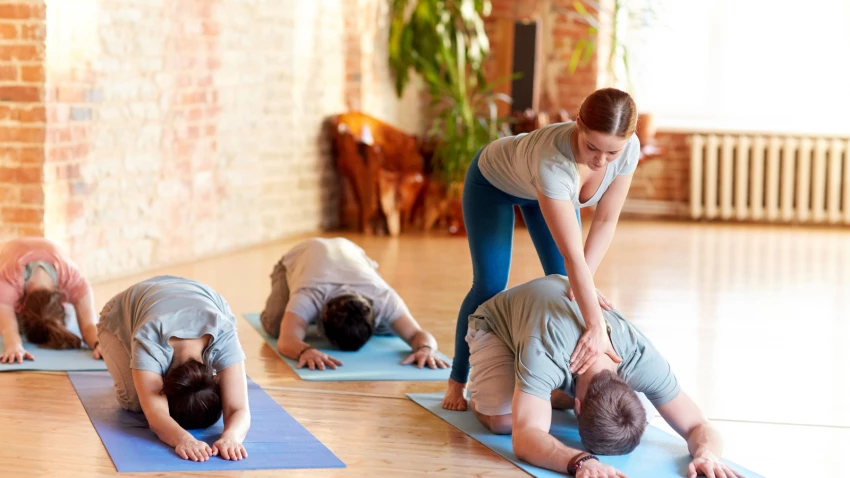Balasana – Child’s Pose: Coming Home

You could call Balasana the original yoga pose. It’s the first pose any of us ever practiced. Before venturing out into the big world, we spent many months curled up inside our mothers. It’s no wonder that Child’s Pose feels so familiar and so nurturing.
Benefits of Child’s Pose

While a simple yoga pose, Balasana has numerous benefits. It quiets the mind and restores spent energy. It focuses the breath into the back body, the “rest and digest” (parasympathetic) side, and supports the natural outward expansion of the lungs on each inhalation. Like all forward bends, Child’s Pose turns our focus inward. Balasana provides a respite from the constant motion of our lives.
Balasana has been pigeonholed as a beginner’s yoga pose, and as such, is sometimes discounted by more experienced practitioners. It’s true that Balasana is accessible to most beginners, and is excellent for introducing beginners to the expansive world of their own back bodies. But I would argue that Balasana is not necessarily an easy yoga pose.
Because the mind is not overwhelmed by extreme sensations in Child’s Pose, it is far freer to wander than in the more physically demanding asanas. So, while Balasana might not be challenging to our bodies, it can be quite challenging to our minds.
Balance of Rest and Activity

In a culture where constant activity and the “no pain, no gain” philosophy is the norm, slowing down and resting in a comfortable pose can actually be quite uncomfortable psychologically. How can a yoga pose that feels so good possibly be good for us?
I want to pose a different question: Do we need to forcefully conquer our bodies to be healthy? I propose a different idea: that we practice balance by treating our bodies with care and respect and create a partnership of harmony, where we neither deplete ourselves with constant activity nor fall into inertia when we’ve worn ourselves out.
Balasana is good for us precisely because it feels good. Child’s Pose mirrors the fetal position, the pose of ultimate comfort and security. In Balasana, our back expands and provides a protective shell for our delicate vital organs, which rest in relative calm on our thighs. Resting the forehead on the floor further quiets the mind.
The result is a slowing of the breath and brain activity. Balasana is the perfect foil for an active yoga practice and life. In Balasana, we come home.
Practice Steps for Child’s Pose

- Begin on your hands and knees on a mat or blanket. Take a moment to feel the weight on your hands. Are your palms contacting the floor evenly? Take a moment to even out your hands from side to side and from heels to fingers.
- Now, settle your hips back onto your heels and rest your forehead on the floor. Stretch your arms out in front of you for a few breaths, lengthening all the way from your pelvic floor to the fingertips like a cat stretching out its paws.
- Take a few breaths with your arms actively extended, and then release your arms to your sides and turn your palms up. Allow your shoulder blades to slide out to the sides.
- Imagine that your back is shaped like a tortoise shell, and draw the breath into your back, expanding it out in all directions. Let your breath massage your back from the inside. On your exhalations, let go of any tension you feel anywhere in your body.
- Take as many breaths as you like. When you are ready to come out of the pose, place your hands under your shoulders, ground your shins and knees, press with your hands, and slowly roll your spine up, lifting your head last so that you are sitting on your heels. Relax and breathe naturally.
Contraindications for Child’s Pose
While Balasana is accessible to most yoga practitioners (and non-practitioners), it is not advisable to practice it if you are pregnant or if you have loose bowels. Balasana is also sometimes contraindicated for people with knee problems. However, an experienced teacher may be able to show you how to use blankets to modify the pose so that you can practice safely.
Practice Balasana any time—between active poses in your yoga practice or when you need to slow down and regroup from a busy life. A life of balance includes activity and rest, outward and inward focus, sound, and silence. Balasana can be your peaceful haven.
Also, read...
Picture Perfect Posture: Tadasana (Mountain Pose)
4 Ways to Fit Yoga into Your Day—No Leggings Required
Online Yoga Tutorial: Power Up Your Warrior II – Virabhadrasana II
Related courses

Charlotte Bell began practicing yoga in 1982 and began teaching in 1986. She was certified by B.K.S. Iyengar in 1989 following a trip to Pune. In 1986, she began practicing Insight Meditation with her mentors Pujari and Abhilasha Keays. Her asana classes blend mindfulness with physical movement. Charlotte writes a column for Catalyst Magazine and serves as editor for Yoga U Online. She is the author of two books: Mindful Yoga, Mindful Life, and Yoga for Meditators, both published by Rodmell Press. She also edits Hugger Mugger Yoga Products’ blog and is a founding board member for GreenTREE Yoga, a non-profit that brings yoga to underserved populations. A lifelong musician, she plays oboe and English horn in the Salt Lake Symphony and the folk sextet Red Rock Rondo whose 2010 PBS music special won two Emmys.



